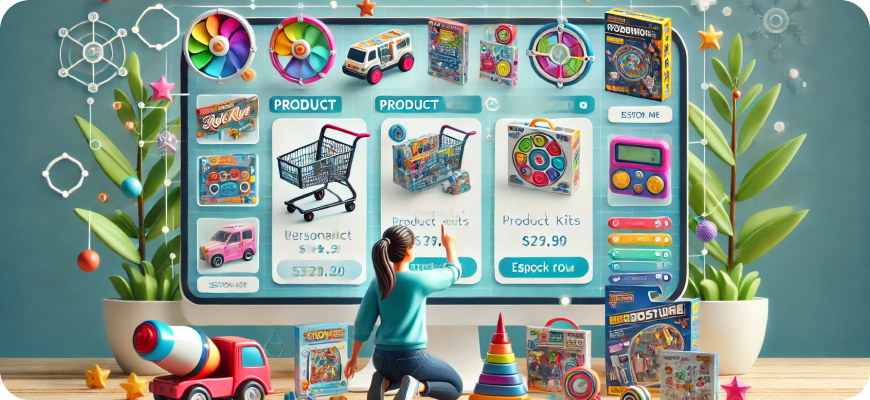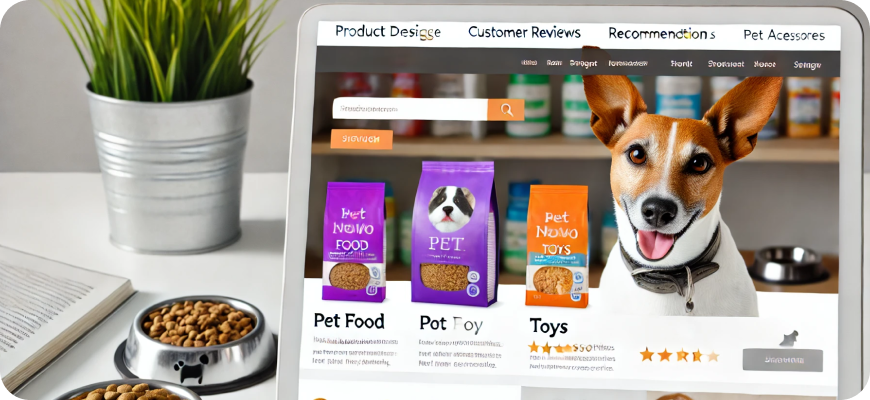How to Build a Strong E-Commerce Growth Strategy
A strong growth strategy is crucial for e-commerce businesses aiming to thrive in an increasingly competitive landscape. While it’s tempting to focus solely on acquiring new customers, a comprehensive growth strategy considers every aspect of the customer journey, from brand awareness and acquisition to customer retention and long-term loyalty. By building a well-rounded approach, you can drive sustainable growth, optimize revenue, and establish a brand that customers return to time and time again. In this article, we’ll explore the steps needed to create a robust e-commerce growth strategy that drives real results.

1. Define Clear Growth Goals and Metrics
Setting clear goals is the foundation of any successful growth strategy. By identifying specific objectives, you can measure success and track progress, ensuring that your efforts are focused and effective.
How to Define Growth Goals:
- Identify Key Performance Indicators (KPIs): Choose metrics that align with your growth goals, such as revenue growth, customer acquisition rate, retention rate, and average order value.
- Set SMART Goals: Use the SMART framework (Specific, Measurable, Achievable, Relevant, and Time-bound) to create goals that are realistic and actionable. For example, “Increase revenue by 25% over the next 12 months” is a clear and measurable goal.
- Align Goals Across Teams: Make sure that all departments understand and are aligned with your growth goals. Whether it’s marketing, customer service, or logistics, a unified approach will ensure cohesive growth efforts.
2. Conduct a Competitive Analysis
Understanding the competitive landscape is essential for positioning your brand effectively and identifying opportunities to differentiate.
Steps for Competitive Analysis:
- Identify Competitors: List both direct competitors (those selling similar products) and indirect competitors (those targeting the same audience).
- Analyze Their Strategies: Examine their product offerings, pricing models, website design, and marketing tactics. Look for strengths and weaknesses.
- Identify Market Gaps: Discover where your competitors may fall short, such as customer service or unique product offerings. These gaps represent opportunities for your brand to stand out.
Tools for Competitive Analysis:
Tools like SEMrush, Ahrefs, and SimilarWeb provide insights into competitors’ web traffic, top keywords, and online visibility, helping you to benchmark your performance.
3. Develop a Comprehensive Brand Identity
Branding is a powerful tool for growth. A strong, consistent brand identity not only attracts customers but also builds loyalty and encourages repeat purchases.
How to Build a Strong Brand Identity:
- Define Your Unique Selling Proposition (USP): Clearly articulate what makes your brand different and why customers should choose you over competitors.
- Establish a Consistent Voice and Tone: Whether on social media, email, or your website, your messaging should be consistent and reflect your brand’s values and personality.
- Create a Memorable Visual Identity: Invest in a cohesive design that includes your logo, color scheme, and website layout to ensure brand recognition across all channels.
4. Optimize the User Experience (UX) on Your Website
Your website is the centerpiece of your e-commerce business. A seamless user experience encourages visitors to explore, engage, and purchase from your store.
Key Areas to Focus On:
- Ensure Fast Loading Speeds: Slow websites drive customers away. Use tools like Google PageSpeed Insights to identify areas for improvement.
- Implement a Mobile-Friendly Design: With a large percentage of e-commerce transactions happening on mobile, a responsive, mobile-optimized design is crucial.
- Simplify Navigation: Make it easy for customers to find what they’re looking for. Use clear categories, filters, and search functionalities.
- Optimize the Checkout Process: Streamline the checkout process by reducing unnecessary steps and offering guest checkout options.
5. Implement a Multi-Channel Marketing Strategy
Relying on a single marketing channel limits your reach. A multi-channel marketing strategy maximizes your visibility and allows you to engage with customers at various touchpoints.
Channels to Consider:
- Search Engine Optimization (SEO): Drive organic traffic by optimizing product pages, blog content, and meta descriptions for relevant keywords.
- Social Media Marketing: Platforms like Instagram, Facebook, and TikTok allow you to reach a broader audience, showcase products, and interact directly with customers.
- Email Marketing: Keep customers informed and engaged with personalized emails, such as welcome sequences, product recommendations, and abandoned cart reminders.
- Influencer Marketing: Partnering with influencers in your niche can introduce your brand to a wider audience and add credibility.
- Paid Advertising (PPC): Use Google Ads, Facebook Ads, or Instagram Ads to target specific customer segments and drive targeted traffic to your site.
6. Use Data Analytics to Drive Decision-Making
Data is at the core of a successful growth strategy. By analyzing customer behavior, sales trends, and campaign performance, you can make informed decisions that drive results.
Key Metrics to Track:
- Conversion Rate: The percentage of visitors who make a purchase. Optimizing for conversion involves improving UX, testing CTAs, and simplifying checkout.
- Customer Lifetime Value (LTV): LTV helps you understand the long-term value of each customer, informing strategies for retention and loyalty.
- Customer Acquisition Cost (CAC): This metric tells you how much it costs to acquire a new customer. Compare CAC to LTV to ensure you’re achieving profitable growth.
Tools for Data Analysis:
Use tools like Google Analytics, Shopify Analytics, and Klaviyo to gain insights into customer journeys, behavior, and conversion paths.
7. Leverage Personalization to Enhance Customer Experience
Personalization is key to creating relevant, engaging experiences that encourage customers to stay loyal to your brand.
How to Personalize the Customer Journey:
- Use Browsing and Purchase History for Recommendations: Suggest products based on previous purchases or recently viewed items, increasing the chances of additional purchases.
- Send Personalized Email Campaigns: Segment customers based on behavior, purchase frequency, or demographics to send targeted emails that resonate with their interests.
- Dynamic Website Content: Show personalized banners, product suggestions, and promotions based on each customer’s preferences or location.
8. Develop a Customer Retention Strategy
Acquiring new customers is more expensive than retaining existing ones. A solid customer retention strategy increases customer lifetime value and brand loyalty.
Retention Strategies to Implement:
- Loyalty Programs: Reward repeat customers with points, discounts, or exclusive perks to incentivize them to continue purchasing.
- Customer Feedback and Support: Engage with customers by asking for feedback and responding promptly to inquiries or issues.
- Post-Purchase Communication: After a purchase, follow up with customers by suggesting complementary products, providing care tips, or offering a discount for their next purchase.
9. Optimize Pricing and Product Offerings
Offering competitive pricing and a strong product mix is essential to attracting and retaining customers.
Strategies to Improve Pricing and Product Offerings:
- Experiment with Dynamic Pricing: Adjust prices based on demand, seasonality, or competitor prices to maximize sales and profitability.
- Expand Product Lines: Consider adding new products or bundling items to increase average order value.
- Use Data to Understand Best-Sellers: Analyze your sales data to identify high-performing products and invest more in promoting these items.
10. Invest in High-Quality Content Marketing
Content marketing is an effective way to build brand awareness, establish authority, and engage customers. Quality content builds trust and attracts organic traffic to your site.
Types of Content to Focus On:
- Product Tutorials and Guides: Help customers make informed decisions with detailed guides on how to use or select products.
- Blog Content: Create SEO-optimized blog posts that address customer pain points, answer common questions, and showcase your expertise.
- Video Content: Videos, including product demos, tutorials, and customer testimonials, drive engagement and provide valuable insights into your offerings.
11. Prioritize Customer Service and Reviews
Exceptional customer service helps you build trust and encourages positive word-of-mouth. Online reviews further enhance credibility, influencing potential buyers.
Steps to Improve Customer Service:
- Provide Multi-Channel Support: Offer support through live chat, email, and phone to cater to different customer preferences.
- Encourage Product Reviews: Send post-purchase emails asking customers to review their purchases. Positive reviews build credibility and encourage new sales.
- Respond to Feedback: Whether feedback is positive or negative, responding promptly shows that you value customer input and are dedicated to improvement.
12. Implement A/B Testing for Continuous Improvement
Testing different elements of your e-commerce site, emails, and ads is crucial for identifying what works best and optimizing for growth.
How to Run A/B Tests:
- Test One Variable at a Time: Start with a specific variable, such as headline, CTA, or product page layout, and measure its impact on performance.
- Use Testing Tools: Platforms like Google Optimize, Optimizely, and Unbounce allow you to conduct A/B tests and gain insights on which changes improve conversion rates.
- Make Data-Driven Decisions: Analyze the results of your tests and implement winning variations to continuously improve user experience and sales performance.
13. Expand Internationally for New Market Opportunities
Expanding internationally can unlock new growth avenues for your e-commerce business. However, it’s essential to adapt your offerings and strategies to fit each market.
Steps for International Expansion:
- Research Market Demand: Identify countries with high demand for your products and evaluate local competition.
- Adapt Language and Currency: Offer localized language options and display prices in local currency to enhance the shopping experience.
- Address Shipping and Fulfillment: Partner with international fulfillment providers and consider offering local returns to build trust with international customers.
14. Adopt Sustainable and Ethical Practices
Sustainability has become a key concern for many consumers. Adopting ethical practices can differentiate your brand and appeal to conscious shoppers.
How to Implement Sustainable Practices:
- Eco-Friendly Packaging: Use biodegradable, recyclable, or minimal packaging materials to reduce waste.
- Ethical Sourcing: Ensure that your products are made ethically, using fair labor practices and sustainable materials.
- Communicate Your Efforts: Share your sustainability initiatives with customers through your website, emails, and social media to build trust and loyalty.

Conclusion
Building a strong e-commerce growth strategy requires a comprehensive approach that considers every stage of the customer journey. From defining clear goals and analyzing competitors to optimizing the user experience and adopting sustainable practices, each step contributes to long-term, sustainable growth. By focusing on customer needs, leveraging data, and continuously improving your offerings, you can create an e-commerce business that not only attracts new customers but also retains loyal ones, setting your brand up for success in an ever-evolving market.






